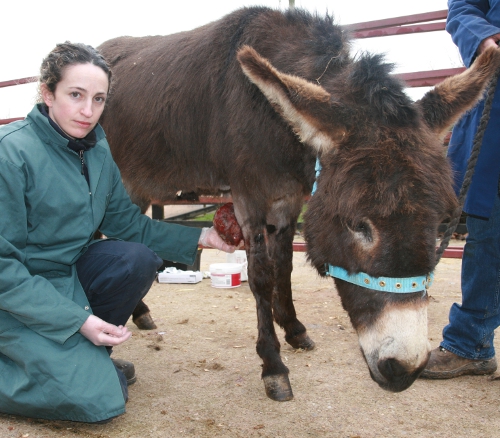There are sarcoids and there are Sarcoids. And then, every once in a while, you see a horse with a single SARCOID. I’m happy to share this story with you, because it has a happy ending.

In England, a two-year-old donkey named Burt arrived at international animal welfare charity The Donkey Sanctuary recently with a tumor-like skin growth on his elbow the size of a large grapefruit. The tumor was located at the back of his elbow, and resembled an over-sized, angry shoe boil. A bulging tumor in that location would prevent a horse or donkey from being able to lie down and get up again, and it would probably interfere with movement. Burt needed help.
The tumor, known to veterinarians as a sarcoid, was literally hanging off by threads of tissue. It had been bleeding constantly and had rubbed against Burt’s other leg, causing him great discomfort.
What is a sarcoid?
According to the web site of the
University of Minnesota College of Veterinary Medicine
, an equine sarcoid is a type of skin tumor thought to be caused by exposure to a bovine papilloma virus.? These tumors grow and spread when irritated, and are of great frustration to owners because there is no consistently effective treatment.? The tumors have tendrils, which can invade throughout adjacent muscle tissue, and make complete surgical removal difficult.? The tumors are not malignant (meaning that they do not spread through blood or lymph to additional sites) but can be very difficult to control.? Not only can sarcoids be quite ghastly in appearance, but also they can affect a horse’s comfort.
Burt’s sarcoid had progressed at an alarming rate, which was very distressing for both the donkey, and his owners, who told the Sanctuary: “Burt’s sarcoid first appeared in December but it was very small and didn’t bleed. It didn’t appear to affect him, either, but after a few weeks it suddenly became the size of a golf ball, then a small orange…it bled and it just continued to grow.
“With Burt’s sarcoid growing rapidly out of control, and our forthcoming house move to a property with no land, we made the heart breaking decision to hand Burt and his lovely friend, Jacko, over to The Donkey Sanctuary, where they would both be given expert care and Burt’s sarcoid could be treated by the experienced veterinary team.”
[VIDEOSINGLE type=”youtube” keyid=”A0xXUyX7L3M”, width=”560″, height=”344″]
Elena Barrio who has been a veterinary surgeon at the Sanctuary for five years says: “This is a very large sarcoid and it is seems fairly aggressive, as it has grown at such a fast pace.
“The treatment will be ongoing for sometime but we are hopeful that Burt will make a full recovery and will enjoy spending the rest of his life in our care with Jacko.
“If you own a donkey (or horse) and suspect it has a sarcoid, it is important to consult your vet as soon as it appears. Please do not attempt to treat it yourself as the most suitable treatment required will depend on the type of sarcoid and this decision should be made by a vet”.
Are you a donkey fan? If you own a donkey or would like further information and advice about donkeys, a wonderful resource is the Donkey Sanctuary’s web site: www.thedonkeysanctuary.org.uk









